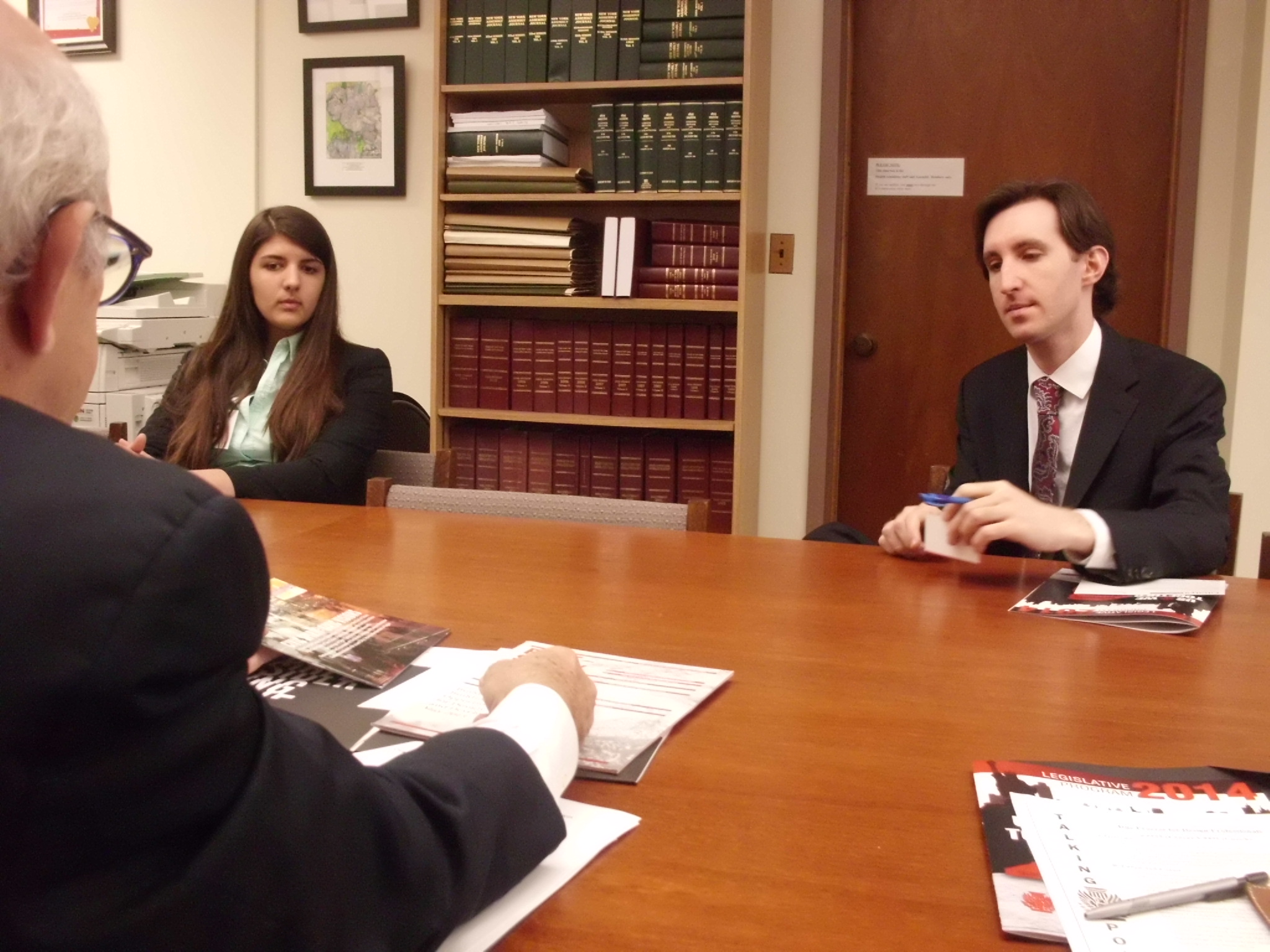by: EmmaPattiz
AIA New York State 2014 Albany Lobby Day took place on 04.29.14. With a series of important issues to press, an enthusiastic delegation from AIANY took to the Capitol.
All of our meetings were informative and productive, but our meeting with Assemblymember Deborah Glick was particularly significant because she is chair of the Assembly Higher Education Committee, the committee currently considering passage of the Good Samaritan Act. This legislation would provide protections for architects who volunteer necessary services to the public during disasters and emergencies, as determined by the governor. Following Superstorm Sandy, the need for this legislation was made very apparent when willing architects hesitated to respond without proper protections. This bill needs a final push to get it through the Assembly Higher Education Committee.
We also had a chance to address our opposition to Professional Certification License Suspension, also in the Assembly Higher Education Committee. Professional Certification License Suspension would require the New York State Board of Regents to immediately suspend the professional license of any architect or engineer upon a determination by the NYC Department of Buildings (DOB) that such individual had “seriously abused” the professional certification program. Design professionals, however, are licensed by the State Education Department, not the DOB. Glick reiterated our sentiments that there are bad actors out there, but the DOB should not have the right to revoke certifications. She is confident that it will not leave the committee, which was encouraging.
During our meeting with Assemblymember Herman D. Farrell, we also discussed the Good Samaritan legislation and the resources that architects could provide to the public with certain protections. The assemblymember expressed a particular interest in risk and resiliency, recalling the MTA’s bold decision to shut down the subway system before Sandy, and emphasized the need to be prepared. He was also interested in designing for earthquakes, which is the focus of “Considering the Quake,” currently on view at the Center for Architecture.
Other issues included Design Liability Reform, which would enact a 10-year statute of repose and a one-year limit for any suit brought against a licensed design professional, and our opposition to Interior Design Practice Expansion, which would allow interior designers to submit specifications for the design and construction of interior spaces to obtain building permits.
Last week, government officials, community organizers, academics, and professionals also gathered at two important conferences to discuss the future of sustainable policy and development in the New York City region.
On Thursday, 04.24.14, the Metropolitan Waterfront Alliance (MWA) held the 2014 Waterfront Conference, “Rebuilding our Waterfront: From the Water In, From the Grassroots Up.” The conference took place aboard the Hornblower Infinity, docked at Pier 40 before departing for a cruise for the afternoon programs.
This year’s Waterfront Conference focused on equity and resilience, highlighting new ideas for enhancing transportation on and near the water and innovative edge design. The panels were composed of experts from the federal, state, and city government, and community-based organizations working diligently to improve New York City’s waterfronts. Christopher O. Ward, executive vice president, Dragados USA and chair, MWA Board of Trustees, delivered the keynote address.
Ward concentrated on the role of the Port Authority of New York and New Jersey (PA) in the future of the city’s waterfronts. He discussed how the PA grew out of the progressive era and worked well building major infrastructure in and around New York City while earning income with the growth of the automobile industry. Eventually, the PA lost sight of its core mission and began moving beyond transportation issues, which resulted in financial recession. Ward emphasized the need for a more transparent PA. Toll income has flatlined, but there is a need for updated infrastructure and a desire for public engagement. The Authority must bolster confidence with new ideas.
Panelists throughout the day included, among many others: Holly Leicht, Regional Administrator, Region II, U.S. Department of Housing and Urban Development; Daniel Zarrilli, P.E., Director of Resiliency, NYC Mayor’s Office of Long-Term Planning and Sustainability; Jeanne DuPont, Executive Director, Rockaway Waterfront Alliance; Kyle Kimball, President, NYC Economic Development Corporation; Ydanis Rodriguez, New York City Council Member, 10th District, Chair of Committee on Transportation; and Regina Myer, President, Brooklyn Bridge Parks. Speakers addressed the need for a holistic approach to strategic planning and advancing our use of the waterfront, which will require rebuilding and replacing infrastructure.
The Regional Planning Assembly, on Friday, 04.26.14, highlighted the need for regional coordination in order to successfully carry out local initiatives related to resiliency, housing, transportation, and economic development. The keynote speaker was U.S. Senator Christopher S. Murphy of Connecticut. Murphy provided specific examples from his state that address the need for advanced transportation initiatives. He believes that such advancements would have a positive impact on vast economic discrepancies and social inequalities plaguing much of his state.
NYC Mayor Bill de Blasio also gave remarks during the Luncheon Program. He emphasized the lack of federal government assistance at the regional level, and the need for mayors and cities to collaborate. De Blasio noted that, in terms of planning, we were not careful enough in the past. We must use planning as a tool to catch up, and we are currently defined by “fragile successes,” he said. People continue to flock to our cities and planners must protect them by improving systems and investing in the future.
The knowledge communities created by such conferences are crucial in the contemporary political environment. The policy initiatives and adaptations discussed will become increasingly relevant to architects in the region.
Emma Pattiz is the AIANY Policy Coordinator.









